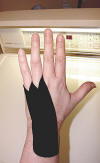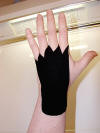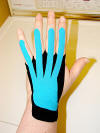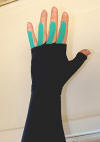KINESIO TAPING A lymphedema HANDSupplies Needed:
(Please click on all thumbnails for full size pictures)

You will need a roll of KT and a pair of scissors for cutting the tape. Kinesio Tape currently comes in 4 colors - Black, Blue, Pink and Beige. It is available in standard and water resistant. It is also available in 2inch or 3inch widths.
The roll on the far left in the picture above is the original KT packaging that was used up til Spring 2008. New packaging was introduced in early 2008 with the name Kinesio Tex GOLD which has the same adhesive wave pattern as the original KT and is the KT that should be used for LE taping. (see the 3 rolls of KT GOLD in the picture above) If you see KT sold as Kinesio Tex PLATINUM you should avoid using that tape for LE because the straight line wave pattern of the adhesive is not as effective and may cause more skin damage.
In addition to the tape you will need a good pair of scissors. Try to find a pair of Teflon coated scissors which will cut the KT without the tape sticking to and gumming up the scissor blades. You can find Teflon coated scissors at most craft stores.
The KT has a paper backing which is marked by lines to help you determine the lengths you need to cut. See picture below for an example of the standard paper backing:

The length of each section between the vertical lines is 2 inches. You will learn with practice how many sections of tape you need to cover different body parts.
The picture below shows the classic wave pattern of the adhesive of KT GOLD. Make sure the tape you use has this type of pattern and not the straight line pattern of the Platinum version of KT.

Cutting the Tape:
When I tape my lymphedema hand I cut 2 different shapes in the tape. The first shape is called a "Buttonhole Cut." The purpose of the buttonholes is to have holes you can insert your fingers into and then apply the tape to both the dorsal and palmar sides of your hand.
To make a buttonhole cut I start out by cutting a length of KT about 5 sections long. I then fold the tape in half.

I then use the scissors to round the cut ends of the tape. (Rounded edges are less likely than a square cut edge to pull loose when pulling sleeves and gloves over top the tape) After rounding the cut ends, I cut diagonal cuts in the folded end as shown in the picture below.

When you open out the tape after cutting it should look similar to the picture below.

I generally cut 2 identical buttonhole strips since I prefer to fully cover the dorsum and palmar surfaces of my hand with KT. If you choose to use just one strip of KT on your hand you should insert the 2 side by side fingers that most need reduction of swelling into the buttonholes.
Applying the Kinesio Tape:
I insert my little finger and ring finger into the first strip holes. I work the tape down both fingers until I can apply the body of the tape to my palm and back of my hand. When applying the tape I hyperextend or flex my wrist so that the tape is applied over my stretched hand. Again please refer to Ruth Coopee's instructions above on the amount of stretch to apply to the tape and how to leave no stretch on the ends of the tape.
Picture of first strip of tape on the dorsum surface of hand:

Picture of first strip of tape on the palmar surface of hand:

I then apply the second strip of tape to my middle and index fingers in the same manner:

After applying the buttonhole strips I then cut a "Fan Cut" strip which I use to apply to my fingers. I usually cut a length of tape about 3-4 sections long, but this should be adjusted for individual hand length and how much of your fingers you want to cover. I round the corners on one edge of the tape and then I cut the other end of the tape into 4 equal sections about 2 thirds of the way down to the rounded end. I shorten the one section that will cover my little finger and I then round each of the ends of the 4 sections. This is what the fan cut would look like:

I apply the fan cut strip of KT by placing the lower rounded edge near my wrist on top of the KT already applied to the back of my hand. I then slightly stretch each of the cut sections to apply to each of my fingers again with a slight stretch while I flex my fingers. The finished KT application which covers the dorsum, palmar surfaces and all 4 fingers should look something like this:

The KT should never be worn as a substitute for your compression glove and sleeve, but rather is worn underneath your glove and sleeve. The tape can remain in place for 4-5 days before it should be removed. I prefer to use the water resistant KT because it withstands showering and getting wet better than the standard KT.
The next picture shows me wearing the KT underneath a Juzo Dream Sleeve and Gauntlet in navy color. I do not generally wear a gauntlet because I need the full compression of a fingered glove, but I wanted to show the KT underneath the garments.

I have found that KT on my hand along with my compression glove helps to reduce swelling and fibrosis even more than just wearing my glove alone.
Linda Lou



